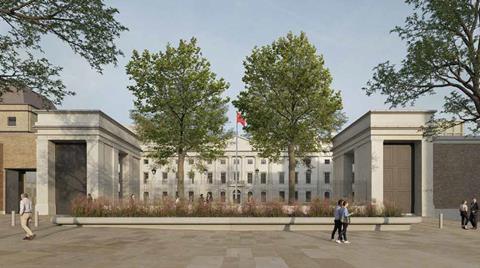Eight-day public inquiry into transformation of former Royal Mint to start in February

Tower Hamlets council has refused David Chipperfield’s plans to transform the former Royal Mint into China’s UK embassy in a symbolic move following Angela Rayner’s decision to call in the scheme.
Councillors voted unanimously to refuse the scheme in a special meeting of the council’s strategic development committee on Monday despite the plans being recommended for approval by planning officers.
Rayner called in the 600,000 sq ft scheme in October and notified the council of her intention to hold a public inquiry with the planning inspectorate, which will start on 11 February and run for an initial period of eight days.
The secretary of state’s intervention came three months after Chipperfield resubmitted the application for the scheme, which had been rejected by Tower Hamlets in 2022 due to security and heritage concerns. The new application contains no major changes.
The purpose of the council’s vote to approve was to demonstrate how it would have determined the scheme if it had the opportunity to do so. The decision will form the basis for the council’s case at the upcoming inquiry.
Rayner did not give specific reasons why she took charge of the scheme but was said in a letter sent to the council by the Ministry of Housing, Communities and Local Government to want to look into the extent to which the proposed development is consistent with the development plan for the area.
The letter also listed the extent to which the scheme is consistent with government policies for ‘Conserving and Enhancing the Historic Environment’ in the National Planning Policy Framework as among issues the secretary of state “particularly wishes to be informed about”.
Under Chipperfield’s plans for the site, the grade II*- listed Johnson Smirke Building would be refurbished as the main embassy building to host formal reception spaces and offices.
The grade II-listed Seaman’s Registry would also be refurbished under the scheme with various additions to both buildings, which were carried out as part of the mint’s redevelopment in the 1980s, due to be replaced.
Two linked blocks constructed as part of the 1980s redevelopment, Dexter House and Murray House, would be separated and reconfigured, with Murray House stripped back to its frame to create a new ceramic-clad cultural centre.




























No comments yet